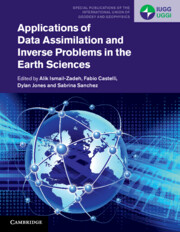Book contents
- Applications of Data Assimilation and Inverse Problems in the Earth Sciences
- Series page
- Applications of Data Assimilation and Inverse Problems in the Earth Sciences
- Copyright page
- Contents
- Contributors
- Preface
- Acknowledgements
- Part I Introduction
- Part II ‘Fluid’ Earth Applications: From the Surface to the Space
- Part III ‘Solid’ Earth Applications: From the Surface to the Core
- 11 Trans-Dimensional Markov Chain Monte Carlo Methods Applied to Geochronology and Thermochronology
- 12 Inverse Problems in Lava Dynamics
- 13 Data Assimilation for Real-Time Shake-Mapping and Prediction of Ground Shaking in Earthquake Early Warning
- 14 Global Seismic Tomography Using Time Domain Waveform Inversion
- 15 Solving Larger Seismic Inverse Problems with Smarter Methods
- 16 Joint and Constrained Inversion as Hypothesis Testing Tools
- 17 Crustal Structure and Moho Depth in the Tibetan Plateau from Inverse Modelling of Gravity Data
- 18 Geodetic Inversions and Applications in Geodynamics
- 19 Data Assimilation in Geodynamics: Methods and Applications
- 20 Geodynamic Data Assimilation: Techniques and Observables to Construct and Constrain Time-Dependent Earth Models
- 21 Understanding and Predicting Geomagnetic Secular Variation via Data Assimilation
- 22 Pointwise and Spectral Observations in Geomagnetic Data Assimilation: The Importance of Localization
- Index
- References
19 - Data Assimilation in Geodynamics: Methods and Applications
from Part III - ‘Solid’ Earth Applications: From the Surface to the Core
Published online by Cambridge University Press: 20 June 2023
- Applications of Data Assimilation and Inverse Problems in the Earth Sciences
- Series page
- Applications of Data Assimilation and Inverse Problems in the Earth Sciences
- Copyright page
- Contents
- Contributors
- Preface
- Acknowledgements
- Part I Introduction
- Part II ‘Fluid’ Earth Applications: From the Surface to the Space
- Part III ‘Solid’ Earth Applications: From the Surface to the Core
- 11 Trans-Dimensional Markov Chain Monte Carlo Methods Applied to Geochronology and Thermochronology
- 12 Inverse Problems in Lava Dynamics
- 13 Data Assimilation for Real-Time Shake-Mapping and Prediction of Ground Shaking in Earthquake Early Warning
- 14 Global Seismic Tomography Using Time Domain Waveform Inversion
- 15 Solving Larger Seismic Inverse Problems with Smarter Methods
- 16 Joint and Constrained Inversion as Hypothesis Testing Tools
- 17 Crustal Structure and Moho Depth in the Tibetan Plateau from Inverse Modelling of Gravity Data
- 18 Geodetic Inversions and Applications in Geodynamics
- 19 Data Assimilation in Geodynamics: Methods and Applications
- 20 Geodynamic Data Assimilation: Techniques and Observables to Construct and Constrain Time-Dependent Earth Models
- 21 Understanding and Predicting Geomagnetic Secular Variation via Data Assimilation
- 22 Pointwise and Spectral Observations in Geomagnetic Data Assimilation: The Importance of Localization
- Index
- References
Summary
Abstract: In this chapter, we review basic methods for data assimilation used in geodynamic modelling: backward advection (BAD), variational/adjoint (VAR), and quasi-reversibility (QRV). The VAR method is based on a search for model parameters (e.g. mantle temperature and flow velocity in the past) by minimising the differences between present observations of the relevant physical parameters (e.g. temperature derived from seismic tomography, geodetic measurements) and those predicted by forward models for an initial guess temperature. The QRV method is based on introduction of the additional term involving the product of a small regularisation parameter and a higher-order temperature derivative into the backward heat equation. The data assimilation in this case is based on a search of the best fit between the forecast model state and the observations by minimising the regularisation parameter. To demonstrate the applicability of the considered data assimilation methods, a numerical model of the evolution of mantle plumes is considered. Also, we present an application of the data assimilation to dynamic restoration of the thermal state of the mantle beneath the Japanese islands and their surroundings. The geodynamic restoration for the last 40 million years is based on the assimilation of the present temperature inferred from seismic tomography, and constrained by the present plate movement derived from geodetic observations, and paleogeographic and paleomagnetic plate reconstructions. Finally, we discuss some challenges, advantages, and disadvantages of the data assimilation methods.
Keywords
- Type
- Chapter
- Information
- Publisher: Cambridge University PressPrint publication year: 2023



